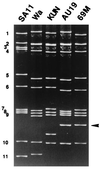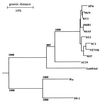Isolation of a human rotavirus strain with a super-short RNA pattern and a new P2 subtype
- PMID: 10074557
- PMCID: PMC88680
- DOI: 10.1128/JCM.37.4.1213-1216.1999
Isolation of a human rotavirus strain with a super-short RNA pattern and a new P2 subtype
Abstract
Super-short rotavirus strains that have a rearranged gene segment 11 are rarely found in humans, and only five isolates, all from Southeast Asia, have been described in the literature. We report the first isolation in Japan from an infant with severe diarrhea of a rotavirus possessing a super-short RNA pattern. This strain, designated AU19, had a G1 VP7 and is also the first isolate in Japan that possesses a P2[6] VP4. Furthermore, the P2[6] VP4 carried by AU19 was divergent in the hypervariable region of the amino acid sequence from the P2A[6] VP4s carried by asymptomatic neonatal strains or from the P2B[6] VP4 carried by porcine rotavirus strain Gottfried. Thus, AU19 is likely to represent a new VP4 subtype, which we propose to call P2C. Given the recent emergence of the P2[6] VP4s in India, Brazil, and the United States and the role of VP4 in protective immunity, further scrutiny is justified to see whether the emergence of the previously underrepresented P2[6] VP4 serotype is related to this new P2 subtype.
Figures


Similar articles
-
Molecular and serologic characterization of novel serotype G8 human rotavirus strains detected in Blantyre, Malawi.Virology. 2000 Sep 1;274(2):309-20. doi: 10.1006/viro.2000.0456. Virology. 2000. PMID: 10964774
-
Emergence of rotavirus G4P8 strain among children suffering from watery diarrhea in Calcutta, India.Intervirology. 2001;44(5):306-10. doi: 10.1159/000050062. Intervirology. 2001. PMID: 11684892
-
Nucleotide sequence of the VP7 gene of human rotavirus isolated in Calcutta, India: possible emergence of a new subtype of serotype I.Intervirology. 1998;41(2-3):127-31. doi: 10.1159/000024924. Intervirology. 1998. PMID: 9820847
-
Antigenic relationships among human rotaviruses as determined by outer capsid protein VP4.Proc Natl Acad Sci U S A. 1990 Sep;87(18):7155-9. doi: 10.1073/pnas.87.18.7155. Proc Natl Acad Sci U S A. 1990. PMID: 1698292 Free PMC article.
-
The VP4 and VP7 of bovine rotavirus VMRI are antigenically and genetically closely related to P-type 5, G-type 6 strains.Vet Microbiol. 1996 Aug;51(3-4):241-55. doi: 10.1016/0378-1135(96)00050-8. Vet Microbiol. 1996. PMID: 8870187
Cited by
-
Detection of a porcine-like rotavirus in a child with enteritis in Italy.J Clin Microbiol. 2008 Oct;46(10):3501-7. doi: 10.1128/JCM.00983-08. Epub 2008 Aug 13. J Clin Microbiol. 2008. PMID: 18701665 Free PMC article.
-
Predominance of porcine rotavirus G9 in Japanese piglets with diarrhea: close relationship of their VP7 genes with those of recent human G9 strains.J Clin Microbiol. 2005 Mar;43(3):1377-84. doi: 10.1128/JCM.43.3.1377-1384.2005. J Clin Microbiol. 2005. PMID: 15750112 Free PMC article.
-
Characterization of serotype G9 rotavirus strains isolated in the United States and India from 1993 to 2001.J Clin Microbiol. 2003 Jul;41(7):3100-11. doi: 10.1128/JCM.41.7.3100-3111.2003. J Clin Microbiol. 2003. PMID: 12843049 Free PMC article.
-
Recommendations for the classification of group A rotaviruses using all 11 genomic RNA segments.Arch Virol. 2008;153(8):1621-9. doi: 10.1007/s00705-008-0155-1. Epub 2008 Jul 5. Arch Virol. 2008. PMID: 18604469 Free PMC article.
-
Identification of porcine rotavirus-like genotype P[6] strains in Taiwanese children.J Med Microbiol. 2012 Jul;61(Pt 7):990-997. doi: 10.1099/jmm.0.042499-0. Epub 2012 Mar 30. J Med Microbiol. 2012. PMID: 22466032 Free PMC article.
References
-
- Estes M K. Rotaviruses and their replication. In: Fields B N, Knipe D M, Howley P M, editors. Fields virology. 3rd ed. Philadelphia, Pa: Lippincott-Raven Publishers; 1996. pp. 1625–1655.
Publication types
MeSH terms
Substances
Associated data
- Actions
LinkOut - more resources
Full Text Sources
Miscellaneous

